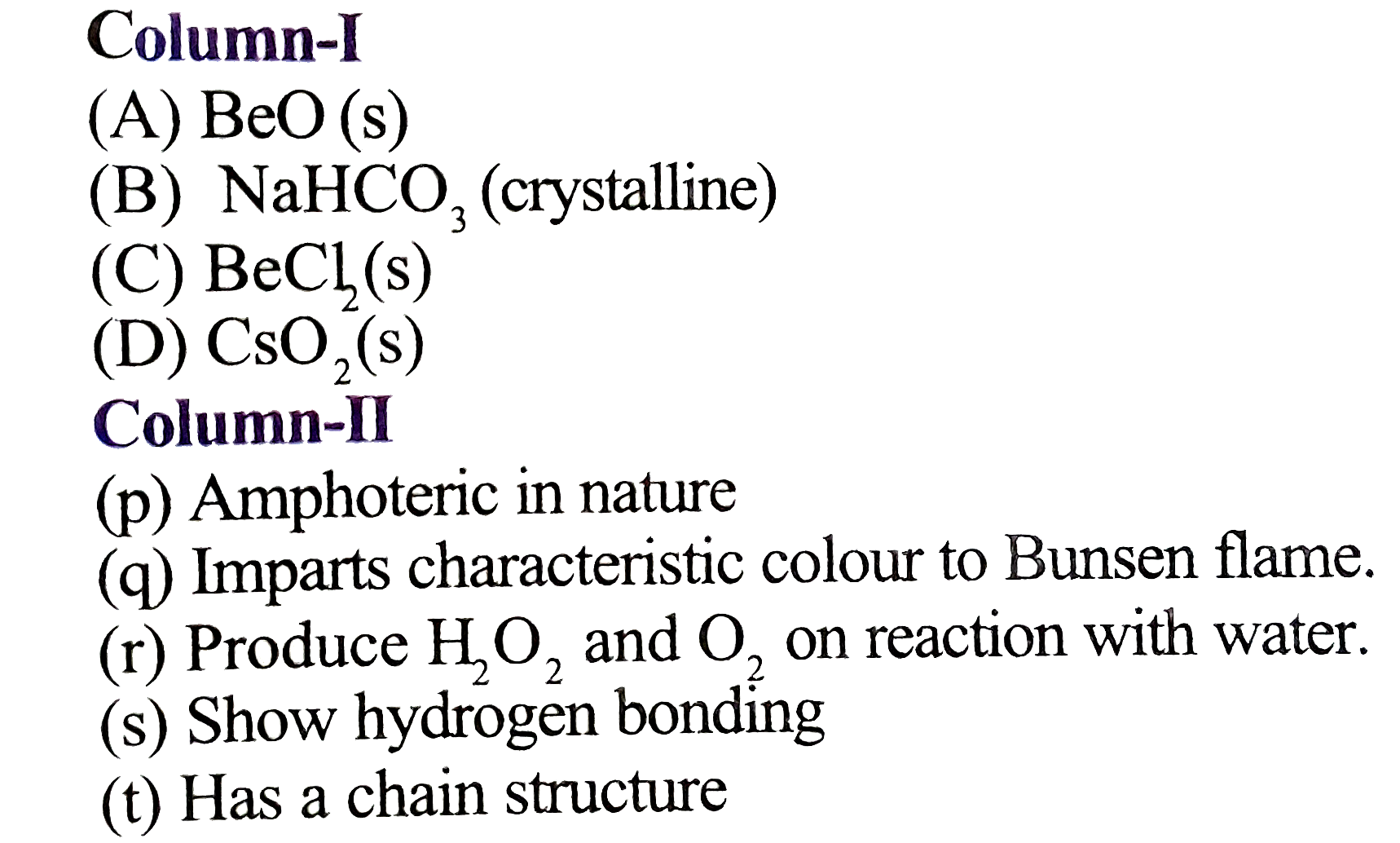Match the extraction processes listed in Column-I with metals listed in Column-II
Column-I Column-II A) Self reductionP) LeadB) Carbon reductionQ) SilverC) Complex formation and displacement by metalR) CopperD) Decomposition of iodi deS) BoronSolution in Telugu
ABCDRPQS
ABCDQDPR
ABCDPQDR
ABCDDPQR
The correct Answer is:A
Step by step video, text & image solution for Match the extraction processes listed in Column-I with metals listed in Column-II {:("Column-I ","Column-II "),("A) Self reduction","P) Lead"),("B) Carbon reduction","Q) Silver"),("C) Complex formation and displacement by metal","R) Copper"),("D) Decomposition of iodi de","S) Boron"):} by Chemistry experts to help you in doubts & scoring excellent marks in Class 12 exams.
Updated on:21/07/2023Topper's Solved these Questions
- PRINCIPLES OF METALLURGYBook:AAKASH SERIESChapter:PRINCIPLES OF METALLURGYExercise:Objective exercise -2 (Occurance and general principles)
Explore 21 Videos
- PRINCIPLES OF METALLURGYBook:AAKASH SERIESChapter:PRINCIPLES OF METALLURGYExercise:Objective exercise -2 (Extraction of some metals)
Explore 29 Videos
- PRINCIPLES OF METALLURGYBook:AAKASH SERIESChapter:PRINCIPLES OF METALLURGYExercise:Objective Exercise - 1 (Iron metallurgy)
Explore 13 Videos
- PRACTICAL CHEMISTRYBook:AAKASH SERIESChapter:PRACTICAL CHEMISTRYExercise:PRACTICE SHEET-5 (Integer answer Type questions)
Explore 6 Videos
- PROTEINS AND NUCLEIC ACIDS Book:AAKASH SERIESChapter:PROTEINS AND NUCLEIC ACIDS Exercise:PRACTICE SHEET - 4
Explore 30 Videos
Similar Questions
List-I List-II (mineral)(type of mineral)1) Beryl a) Sulphate 2) Monosite sand b) Silicate 3) Pentlandite c) Sulphide 4) Anglesite d) Phosphate
View SolutionSodium connot be extracted by electrolysis of aqueous solutions due to
View SolutionMost adundant ore of iron is
View Solution1.575 gm of organic acid was dissolved in 250ml of water 20ml of this solution required 16 ml of N/8 alkali solution for completely neutralization. (M. wt of acid is 126) the basicity of acid is
View SolutionAnti bodies are ………..
View SolutionColumn−I(Ore)Column−II(A)Iron(p)Carbon reduction method(B)Lead(q)Self reduction(C)Copper(r)Thermite process(D)Chromium(s)Hydrometallurgical process
View SolutionMatch the extraction processes listed in column -I with metals listed in column -II and choose the correct option. {:("Column"-I,,"Column"-II),((a)"Self reduction method",,(p)"Aluminium from bauxite"),((b)"Carbon reduction method",,(q)"Mercury from cinnabar"),((c )"Electrolytic reduction method",,(r) "Zinc from zinc blende."),((d)"Cyanide process",,(s)"Silver from agentite"):}
View SolutionMatch the complexes in Column I with their properties listed in Column II
View SolutionMatch the following metals listed in Column I with extraction processes listed in Column II. {:("Column I","Column II"),(A."Silver",p."Fused salt electrolysis"),(B."Calcium",q."Carbon reduction"),(C."Zinc",r."Carbon monoxide reduction"),(D."Iron",s."Amalgamation"),(E."Copper",t."Self-reduction"):}
View SolutionMatch the compounds listed in column -I with the characteristic(s) listed in column-II.

View SolutionMatch the extraction processes listed in column I with metals listed in column II.

View SolutionMatch column (I) with column (II) and select the correct answer using codes given bleow in the lists. {:("Column I","Column II"),("(i) Cyanide process","(a) Extraction of Al"),("(ii) Self reduction","(b) Extraction of Ag"),("(iii) Electrolytic reduction","(c) Extyraction of Cu"),("(iv) Carbon reduction","(d) Extraction of Sn"):}
View SolutionMatch the complexes listed in column-I with characteristic(s) listed in column-II.
View SolutionMatch the extraction processes listed in column I with metals listed in column II.

View SolutionMatch the species listed in column-I with the characteristics/propertie listed in column-II. {:("Column-I","Column-II"),((A)C_2,(p)"Diamagnetic"),((B)N_2,(q)"Undergoes oxidation"),((C )O_2^(2-),(r)"Undergoes reduction"),((D )F_2,(s)"Bond order"ge2),(,(t)"No mixing of 's' and 'p' orbitals"):}
View SolutionMatch the ores listed in column(I) with the appropriate process(es) listed in column (II). {:("Column-I","Column-II"),((A)"Haemalite",(p)"Slag formation"),((B)"Copper pyrites",(q)"Reduction by carbon monoxide (mainly) as well as carbon at different temperature"),(( C)"Carnallite",(r)"Electrolytic reduction"),((D) "Bauxite",(s)"Calcination"),(" " ,(t)"Leaching"):} .
View Solution

